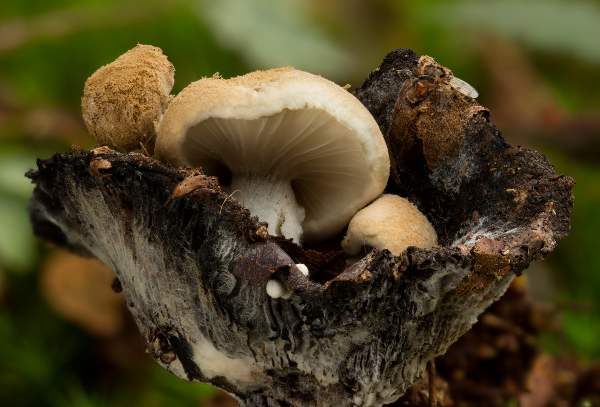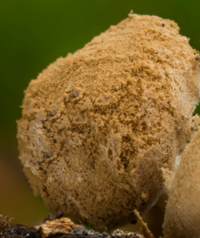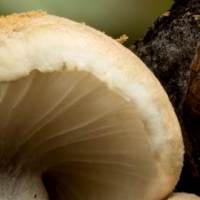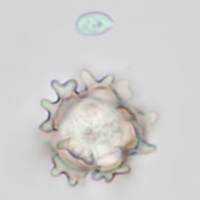Trees Birds Mammals Fish Amphibians Reptiles
Wild Algarve
Bookshop
Asterophora lycoperdoides (Bull.) Ditmar - Powdery Piggyback
Phylum: Basidiomycota - Class: Agaricomycetes - Order: Agaricales - Family: Lyophyllaceae
Distribution - Taxonomic History - Etymology - Identification - Toxicity - Reference Sources

The Powdery Piggyback, Asterophora lycoperdoides, pictured above, is very similar to Asterophora parasitica, the Silky Piggyback, except that the hyphae in its cap surface develop into a brown powdery mass of chlamidospores (asexual spore-like reproductive structures) - an unusual trait for a basidiomycete fungus.
Unlike the Silky Piggyback, the gills of this little white mushroom are rarely well formed and they produce few basidiospores (sexual spores).
The Powdery Piggyback is commonly seen on Russula nigricans, Russula densifolia, Russula fellea and Russula foetens; but there are also a reports of it being found on the decaying caps of certain milkcaps (Lactarius species), most commonly Lactarius vellereus.
Distribution
Fairly widespread but uncommon throughout Britain and Ireland, because of its diminutive size and its habit of fruiting inside decaying fungi that themselves are unlikely to grab the attention, the Powdery Piggyback is easy to miss. This little mushroom is found also in many parts of mainland Europe and in North America.
Taxonomic history
This species was first described in 1791 by the French mycologist Jean Baptiste Francois (Pierre) Bulliard, who gave it the scientific name Agaricus lycoperdoides. (Most gilled fungi were initially placed in a giant Agaricus genus, now redistributed to many other genera.) German mycologist L. P. Fr. Ditmar (a mysterious man whose biographical information appears to be limited to dates of publication) transferred this species to the genus Asterophora inn1809.
Synonyms of Asterophora lycoperdoides include Nyctalis lycoperdoides (Bull.) Konrad & Maubl., Agaricus lycoperdoides Bull., Asterophora agaricoides Fr., and Nyctalis asterophora Fr.
Etymology
Asterophora comes from the Greek words "a'ster" (meaning star) and "phor-" a form of "phero" (meaning to bear or carry) - hence bearing stars, or starry. The coarsely verrucose to blunty spinose chlamydospores do indeed appear to be bearing stars on their surfaces.
The specific epithet lycoperdoides refers to the smell of these fungi; Lycoperdon means 'wolf's flatulence', and the suffix -oides simply implies similarity to Lycoperdon.
Toxicity
These tiny and insubstantial mushrooms are generally reported to be inedible. It is unclear whether they contain any very dangerous toxins, but they should certainly not be collected during fungi forages for food.
Identification guide

|
Cap
0.5 to 1.5cm across; subglobose or convex; white; soon covered in light brown powdery chlamydospores.
|
 |
Gills
White or very pale grey becoming darker grey with age; adnate, thick and distant; often incompletely formed and little more than 'veins'.
Stem
0.5 to 1cm long and 2 to 4mm diameter; white, becoming grey with age; nearly always curved; no stem ring. |
 |
Basidiospores (upper feature, left)
Broadly ellipsoidal, smooth, 5-6 x 3-4µm.
Spore print (basidiospores from young gills)
White.
Chlamydospores (lower feature, left)
13-20 x 10-20 µm, with light brown thick walls and spines, inamyloid; light brown, forming on the cap surface.
|
Odour/taste |
Not significant. |
Habitat & Ecological role |
Saprobic, on various types of decaying brittlegill fruitbodies, particularly the large blackening species Russula nigricans and Russula densifolia. |
Season |
In Britain and Ireland mainly from September to November. |
Similar species |
Asterophora parasitica has a silky cap and generally well-formed gills. |
Reference Sources
Fascinated by Fungi, 2nd Edition, Pat O'Reilly 2016, reprinted by Coch-y-bonddu Books in 2022.
British Mycological Society English Names for Fungi
Dictionary of the Fungi; Paul M. Kirk, Paul F. Cannon, David W. Minter and J. A. Stalpers; CABI, 2008
Taxonomic history and synonym information on these pages is drawn from many sources but in particular from the British Mycological Society's GB Checklist of Fungi.
Acknowledgements
This page includes pictures kindly contributed by David Kelly.
Top of page...
Fascinated by Fungi. Back by popular demand, Pat O'Reilly's best-selling 450-page hardback book is available now. The latest second edition was republished with a sparkling new cover design in September 2022 by Coch-y-Bonddu Books. Full details and copies are available from the publisher's online bookshop...